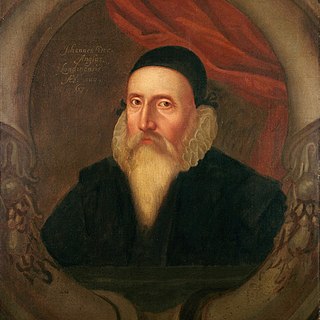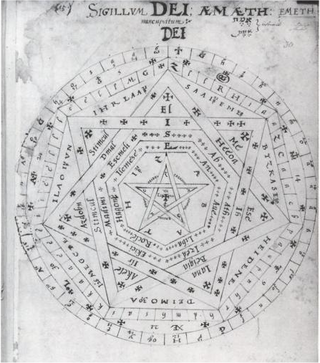
Enochian is an occult constructed language — said by its originators to have been received from angels — recorded in the private journals of John Dee and his colleague Edward Kelley in late 16th-century England. Kelley was a scryer who worked with Dee in his magical investigations. The language is integral to the practice of Enochian magic.

Sir Edward Kelley or Kelly, also known as Edward Talbot, was an English Renaissance occultist and scryer. He is known for working with John Dee in his magical investigations. Besides the professed ability to see spirits or angels in a "shew-stone" or mirror, which John Dee so valued, Kelley also said that he possessed the secret of transmuting base metals into gold, the goal of alchemy, as well as the philosopher's stone itself.

Ceremonial magic encompasses a wide variety of rituals of magic. The works included are characterized by ceremony and numerous requisite accessories to aid the practitioner. It can be seen as an extension of ritual magic, and in most cases synonymous with it. Popularized by the Hermetic Order of the Golden Dawn, it draws on such schools of philosophical and occult thought as Hermetic Qabalah, Enochian magic, Thelema, and the magic of various grimoires. Ceremonial magic is part of Hermeticism and Western esotericism.
The Lesser Key of Solomon, also known as Lemegeton Clavicula Salomonis or simply Lemegeton, is an anonymously authored grimoire on sorcery. It was compiled in the mid-17th century, mostly from materials several centuries older. It is divided into five books: the Ars Goetia, Ars Theurgia-Goetia, Ars Paulina, Ars Almadel, and Ars Notoria. It is based on the Testament of Solomon and the ring mentioned within it that he used to seal demons.
Choronzon is a demon that originated in writing with the 16th-century occultists Edward Kelley and John Dee within the latter's occult system of Enochian magic. In the 20th century he became an important element within the mystical system of Thelema, founded by Aleister Crowley, where he is the "dweller in the abyss", believed to be the last great obstacle between the adept and enlightenment. Thelemites believe that if he is met with proper preparation, then his function is to destroy the ego, which allows the adept to move beyond the abyss of occult cosmology.
True Will is a term found within the mystical system of Thelema. It is defined either as a person's grand destiny in life or as a moment-to-moment path of action that operates in perfect harmony with nature. True Will does not spring from conscious intent, but from the interplay between the deepest self and the entire universe. Thelemites in touch with their True Will are said to have eliminated or bypassed their false desires, conflicts, and habits, and accessed their connection with the divine. Theoretically, at this point, the Thelemite acts in alignment with nature, just as a stream flows downhill, with neither resistance nor "lust of result".

A lamen is a magical pendant or breastplate worn around the neck so that it hangs upon the breast over the heart. Its uses vary but, most commonly, the term refers to a symbol of authority and a focus of magical energies. Aleister Crowley described the lamen as "a sort of coat of arms. It expresses the character and powers of the wearer." Crowley and DuQuette have proposed that the magical lamen might be a modern adaptation of the priestly breastplate of the ancient Hebrews.

Lon Milo DuQuette, also known as Rabbi Lamed Ben Clifford and by his neo-Gnostic bishop title of Tau Lamed, is an American writer, lecturer, musician, and occultist, best known as an author who applies humor in the field of Western Hermeticism.

The Arbatel De Magia Veterum is a Latin grimoire of Renaissance ceremonial magic published in 1575 in Switzerland.

Babalon is a goddess found in the occult system of Thelema, which was established in 1904 with the writing of The Book of the Law by English author and occultist Aleister Crowley. The spelling of the name as "Babalon" was revealed to Crowley in The Vision and the Voice. Her name and imagery feature prominently in Crowley's "Liber Cheth vel Vallum Abiegni".
Within Thelema, the Great Work is the spiritual endeavor aimed at realizing one's True Will and achieving a profound mystical union with the All. This path, crafted by Aleister Crowley, draws inspiration from Hermetic alchemy and the Hermetic Qabalah. The cornerstone of Thelema is the Book of the Law, received by Crowley in 1904 through a communication with the entity Aiwass. This text became the central scripture, heralding a new Aeon for humanity and outlining the principles of Thelema.
Aleister Crowley was an English writer, not only on the topic of Thelema and magick, but also on philosophy, politics, and culture. He was a published poet and playwright and left behind many personal letters and daily journal entries. Most of Aleister Crowley's published works entered the public domain in 2018.

The Vision and the Voice is a book by Aleister Crowley (1875–1947). It chronicles the mystical journey of the author as he explored the 30 Enochian aethyrs originally developed by John Dee and Edward Kelley in the 16th century. These visions took place at two times: in 1900 during his stay in Mexico, and later in 1909 in Algeria in the company of poet Victor Benjamin Neuburg. Of all his works, Crowley considered this book to be second in importance behind The Book of the Law, the text that established his religious and philosophical system of Thelema in 1904. It was first published in 1911 in The Equinox as a "Special Supplement".
A watchtower or guardian in ceremonial magical tradition is a tutelary spirit of one of the four cardinal points or quarters. In many magical traditions, they are understood to be Enochian angels or the Archangels Uriel, Raphael, Michael, and Gabriel. They are also variously associated in other traditions with each of the four classical elements or stars. Originating with the Enochian tradition of John Dee, a version of it was popularized by the Hermetic Order of the Golden Dawn, which became hugely influential in modern Western Esotericism, including Wicca. The watchtowers are invoked during the ritual of casting a magic circle.

John Dee was an English mathematician, astronomer, teacher, astrologer, occultist, and alchemist. He was the court astronomer for, and advisor to, Elizabeth I, and spent much of his time on alchemy, divination, and Hermetic philosophy. As an antiquarian, he had one of the largest libraries in England at the time. As a political advisor, he advocated the foundation of English colonies in the New World to form a "British Empire", a term he is credited with coining.

Hermetic Qabalah is a Western esoteric tradition involving mysticism and the occult. It is the underlying philosophy and framework for magical societies such as the Golden Dawn, has inspired esoteric Masonic organizations such as the Societas Rosicruciana in Anglia, is a key element within the Thelemic orders, and is important to mystical-religious societies such as the Builders of the Adytum and the Fellowship of the Rosy Cross.
Therion (thēríon) is a deity found in the mystical system of Thelema, which was established in 1904 with Aleister Crowley's writing of The Book of the Law. Therion's female counterpart is Babalon, another Thelemic deity. Therion, as a Thelemic personage, evolved from that of "The Beast" from the Book of Revelation, whom Crowley identified himself with since childhood, because his mother called him that name. Indeed, throughout his life he occasionally referred to himself as “Master Therion” or sometimes “The Beast 666”. He wrote:
Before I touched my teens, I was already aware that I was THE BEAST whose number is 666. I did not understand in the least what that implied; it was a passionately ecstatic sense of identity.

The Sigillum Dei is a magical diagram, composed of two circles, a pentagram, two heptagons, and one heptagram, and is labeled with the names of God and its angels. It is an angelic magic seal with the magical function that, according to one of the oldest sources, allowed a destined intended magician to have the power to possess the Spirit of God and when activated can become the 'Living' God; or The Lord God itself; amongst humanity and all creation itself, communicate with spirits as well as angels and archangels, control all elements, control every creature's holy spirit on the planet including the Spirit of God itself; all except for the Archangels, and to control light itself. The intended user also possesses the true benefic vision of God.

James Wasserman was an American writer and occultist. A member of Ordo Templi Orientis since 1976 and a book designer by trade, he wrote extensively on spiritual and political liberty.

Stephen Skinner is an Australian author, editor, publisher and lecturer. He is known for authoring books on magic, feng shui, sacred geometry and alchemy. He has published more than 46 books in more than 20 languages.
















